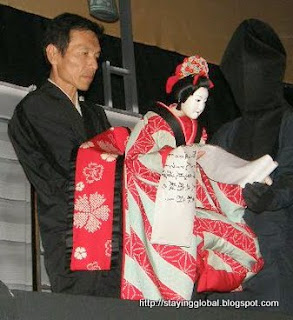I like to collect dolls from places I visit and it all began with my husband’s first trip to Japan, when he picked up a pair of Japanese dolls as a souvenir.
Any
visitor to Japan would be impressed with the kinds of souvenirs and mementos
that they can pick as a memory of their trip. Every sightseeing place, hotel
lobby, shopping complex has something or the other that catches the eye. Even
the shopping area at Narita airport is filled with shops selling the different
kinds of souvenirs. There are the lucky charms, little key chains, the Japanese
fans etc, but the one thing one cannot miss is the little Japanese dolls.
Japanese
dolls are called "Ningyo" and come in all types and kinds, from the ones that imitate the kimono clad
Japanese ladies, to the traditional ones in samurai gear or the cute little
geisha dolls.
One
famous Japanese doll is a “Kokeshi” doll.
These dolls are made of a single
piece of wood and are sculpted and painted to resemble a young girl. Usually
Kokeshi dolls do not have arms or legs and have a big head. Said to have
originated in the northern Tohoku region, there are some onsen towns like
Tsuchiyu which are famous for their Kokeshi dolls. Initially these were sold as
souvenirs at the onsens. These dolls gained popularity among the ordinary
people who could not afford the high priced traditional dolls.
An
elaborate display of dolls, known as "Hina Ningyo" is put up for a month during the “Hina matsuri” or
Girl’s festival in early spring.
I have written about this in an earlier post,
so not writing about it again. The link to the post is : http://stayingglobal.blogspot.com/2011/03/hina-matsuri-girls-festival.html
“Tango
no sekku” or “Boy’s festival” is celebrated on 5th May each year. During this
festival, dolls called “Gogatsu Ningyo” are displayed as part of the ceremony.
Sometimes a samurai protective headgear is also displayed.
In Japan, as a custom sometimes grandparents gift a doll to their grandchildren, usually for the "Hina Matsuri" or "Tango no Sekku".
Daruma
dolls are little lucky charms, which people purchase around New year time.
These are said to resemble the Buddhist monk ‘Bodhidharma” who faced a lot of
hardships but never gave up. People make a wish and paint one eye of the doll keeping
the other unpainted. When the wish is fulfilled, the other eye is painted on.
Japanese
children create small dolls called “Tere Tere Bouzu” by stuffing cotton or
cloth rags inside a white cloth and tying it up with a string.
These dolls are
hung outside the window and are said to bring good weather. Hanging one upside
down indicates the next day to be a rainy day.
Puppet
shows called Bunraku have been popular since old days. Bunraku puppets are
meticulously crafted and designed to mimic human movement.
While
souvenir dolls are reasonably priced (starting prices around 700 yen), the more
elaborate and traditional dolls are sold through special outlets and prices run
up a few hundred thousand yen.









No comments:
Post a Comment